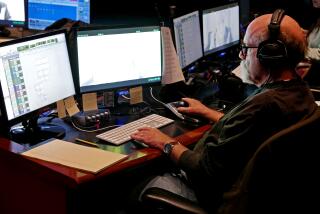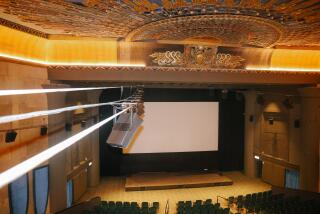The foley field is some racket
Though the computer is now dominating several aspects of filmmaking -- most notably special effects and animation -- there is one craft that has remained blissfully low-tech: that of the foley artist. Since its inception nearly 80 years ago by a man named Jack Foley, foley artists have used everything from cornflakes to fruit to rusty bedsprings to create movie sound effects.
“The violent sounds are the most interesting,” says Scott G.G. Haller, a sound editor and producer of “The Foley Show,” which takes place Wednesday at the American Cinematheque at the Egyptian Theatre in Hollywood.
Last year Haller produced an evening for the American Cinematheque on movie sound design. This year the show will feature a live demonstration by foley artists, supervisors, mixers and editors.
The artists who will be performing Wednesday night are Robin Harlan and Sarah Monat, 20-year veterans of the profession who have worked together at Paramount since 1997.
“Sarah and I had the opportunity to perform live before with Leonard Nimoy,” Harlan says. “They did something called ‘Alien Voices,’ which is a re-creation of old-time radio.... Both of us have acting backgrounds, so we are hams.” “A lot of foley artists come out of acting because there is quite a live performance to it,” adds Monat.
“Acting is to the camera what foley artists are to the sound,” Harlan says. “What we use is sometimes extremely low-tech. We want creaky old hinges. We want to make sure that the doors on our stage creak like crazy. Chairs which you wouldn’t want in your home because they are squeaky, they have all of these beautiful textures. That is what we are interested in capturing.”
Their foley stage at Paramount, says Harlan, “looks like your grandmother’s attic. You have everything there from tricycles to car parts. We also have a dirt pit here, if we have to dig.” They are currently working on a John Singleton film, “Four Brothers,” that has a lot of snow. “We have somebody bring in bags of snow every morning from the ice company, and we set up a drift, and we make sounds and play in this snow all day.”
Feats of foley
Being a foley artist is a physically demanding job that can include running in chase sequences or lifting very heavy objects. (There are about 100 in the country.)
Foley began with the advent of sound in 1927. When “The Jazz Singer” was released, Hollywood started scrambling to make talking pictures and add sound to already completed silent movies. Jack Foley, says Haller, had worked in silent films doing stunts and location scouting. “He was at the right place at the right time,” Haller says.
Universal had filmed Edna Ferber’s novel “Show Boat” as a silent film. But with the success of “The Jazz Singer” and the fact that a musical version of “Show Boat” was the toast of Broadway, the studio re-shot sequences with sound and added sound to the original footage.
The filmmakers realized that more than just talking and music was required; they would need sound effects, and Foley was the guy who figured out how to do it, says Haller. “Eventually soundstages became known as foley stages.”
For the Cinematheque event, a foley stage will be set up in the 12-by-30-foot space beneath the movie screen. The artists will bring different floor surfaces and various props.
Originally, Haller was hoping to keep Monat and Harlan in the dark as to the film that would show for their live performance. “But the problem, of course, is that they have hundreds of thousands of props on their foley stage,” he says. “Since we are creating something temporarily, we can’t really force them to get that creative, to improvise like that.”
Harlan and Monat will be creating sound effects for a 1960s Japanese film called “Black Tight Killers,” an action thriller about a photographer and go-go-dancing ninja assassins.
*
‘The Foley Show’
Where: American Cinematheque at the Egyptian Theatre, 6712 Hollywood Blvd., Hollywood
When: 8 p.m. Wednesday
Price: $6-$9
Contact: (323) 466-FILM or go to www.americancinematheque.com.
More to Read
Only good movies
Get the Indie Focus newsletter, Mark Olsen's weekly guide to the world of cinema.
You may occasionally receive promotional content from the Los Angeles Times.











